What Soil Is Best for Snake Plants?
Snake plants are extremely resilient houseplants. While they can tolerate less-than-ideal conditions, using the proper potting soil benefits their growth and vigor. This blog explores the ideal soil mix to keep your snake plant looking its best.
Contents
Soil Requirements for Snake Plants
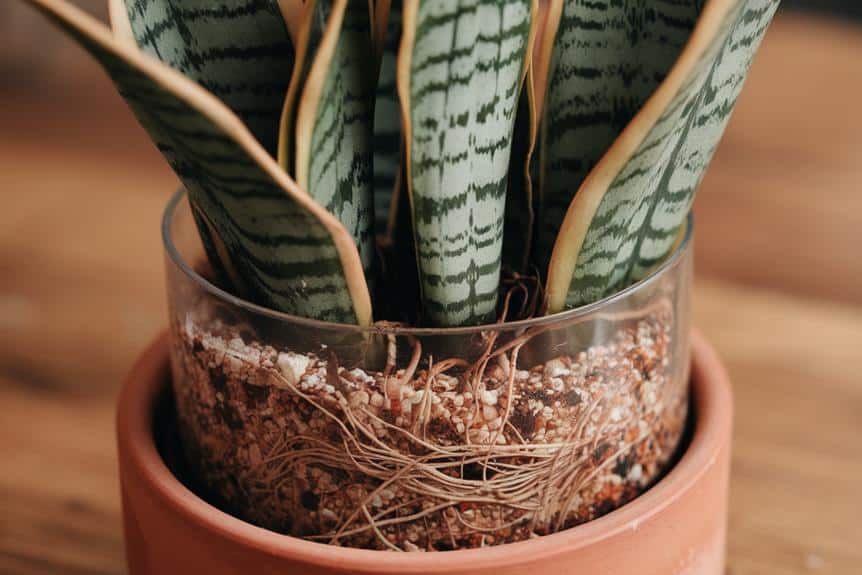
Why are soil requirements essential for snake plants? Proper soil guarantees your snake plant’s health, growth, and longevity. These resilient plants need well-draining soil to prevent root rot and other moisture-related issues. Look for a potting mix that’s light and airy, allowing roots to breathe and excess water to escape quickly.
The ideal soil for snake plants should contain a mix of peat moss, perlite, and coarse sand. This combination provides good drainage while retaining just enough moisture for the plant’s needs. Avoid heavy, clay-like soils that can compact and suffocate the roots. Additionally, ensure the soil pH is slightly acidic to neutral, ranging from 5.5 to 7.0. By providing the right soil conditions, you’ll help your snake plant thrive and serve as a beautiful, low-maintenance addition to any space.
Ideal Soil Composition

The ideal soil composition for snake plants consists of three main components: organic matter, inorganic matter, and air spaces. You’ll want to create a mix that’s well-draining and nutrient-rich. For organic matter, use peat moss or coconut coir to retain moisture and provide nutrients. Inorganic materials like perlite, pumice, or coarse sand improve drainage and aeration. Aim for a ratio of 2 parts organic to 1 part inorganic material.
Ensure your soil mix has enough air pockets to allow roots to breathe and prevent waterlogging. You can achieve this by adding chunky materials like orchid bark or small pebbles. A good rule of thumb is to include about 10-20% of these larger particles in your mix. This composition will help your snake plant thrive, allowing you to enjoy its air-purifying benefits and low-maintenance nature in your home or office.
Commercial Potting Mixes
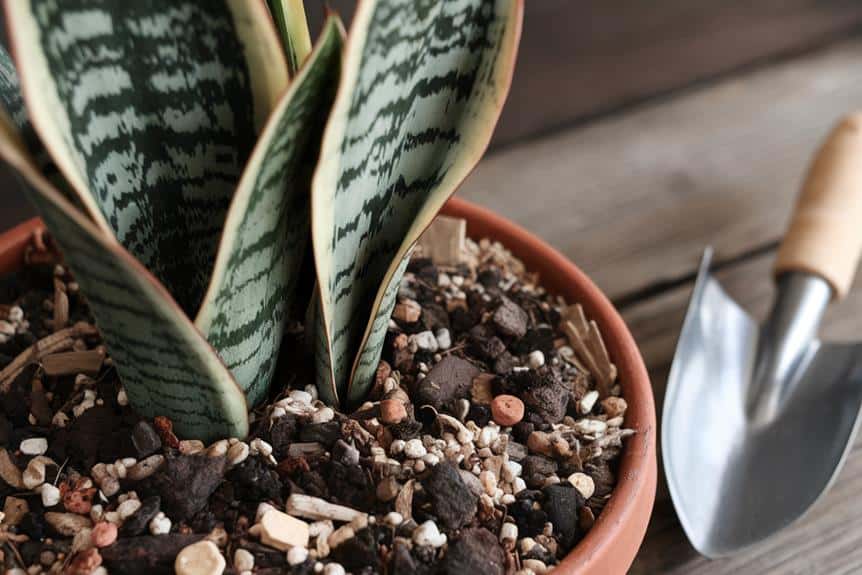
While making your own soil mix is ideal, commercial potting mixes can come in handy for snake plant care. Look for well-draining cactus or succulent mixes that mimic the plant’s natural habitat. These pre-made options often contain a blend of peat moss, perlite, and sand, providing good aeration and drainage.
When choosing a commercial mix, guarantee it’s not too heavy or moisture-retentive. You can improve a standard potting soil by adding extra perlite or coarse sand to enhance drainage. Avoid mixes with water-retaining crystals or excessive organic matter, as these can lead to root rot.
If you’re serving others by caring for their snake plants, recommend a quality commercial mix and explain how to modify it if needed. This approach ensures the plants receive proper care while simplifying the soil selection process for less experienced gardeners.
DIY Snake Plant Soil Recipe
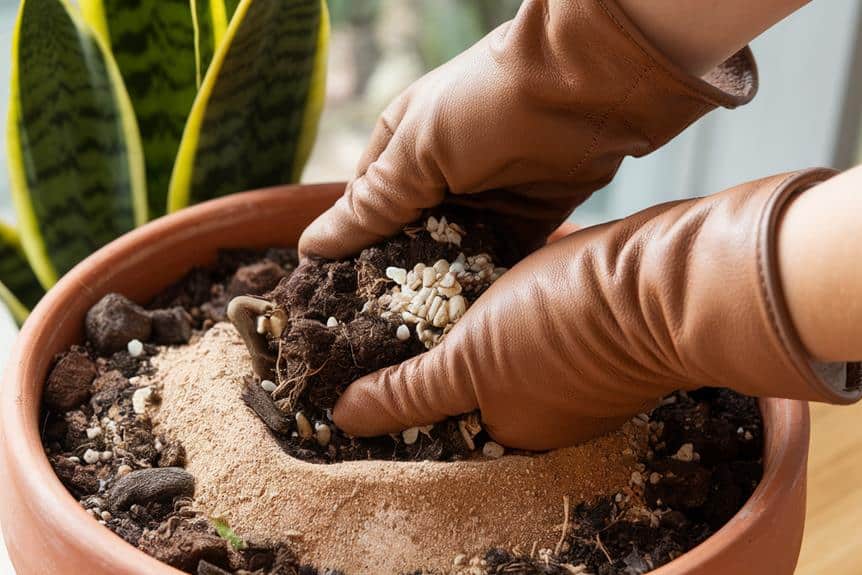
For those who prefer a hands-on approach, creating your own snake plant soil mix can be both rewarding and cost-effective. To craft an ideal DIY soil for your snake plant, combine equal parts of regular potting soil, coarse sand, and perlite. This mixture guarantees excellent drainage and aeration, which are indispensable for your plant’s health.
You can further enhance the mix by adding a small amount of compost or worm castings to provide slow-release nutrients. If you’re looking to improve water retention, consider incorporating some coco coir or peat moss. Remember to adjust the ratios based on your specific growing conditions and the plant’s needs.
Drainage and Aeration Importance
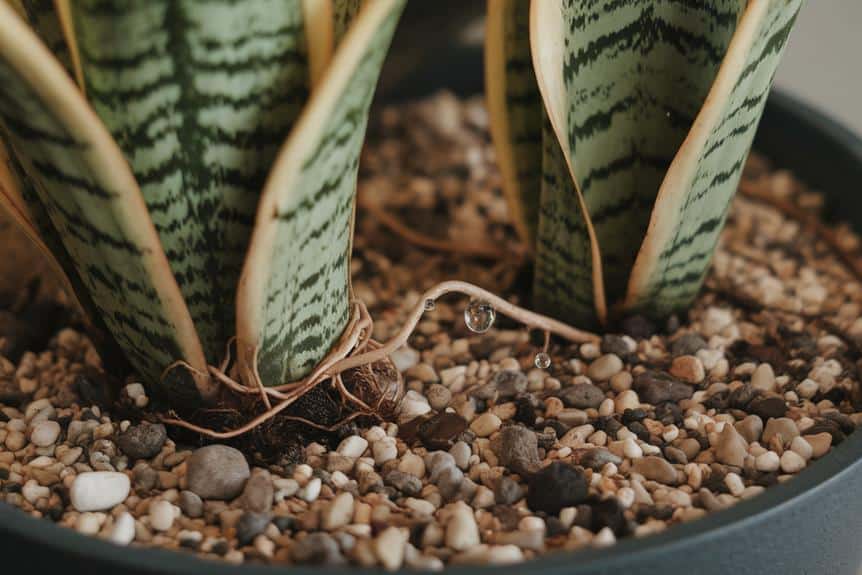
When it comes to snake plant soil, drainage and aeration are the cornerstones of a healthy growing environment. Your snake plant’s roots need oxygen to thrive, and proper drainage prevents water from pooling and causing root rot. To guarantee good drainage, use a well-draining potting mix with plenty of perlite or coarse sand. These materials create air pockets in the soil, allowing roots to breathe and excess water to escape quickly.
Aeration is equally important, as it promotes root growth and nutrient uptake. You can improve aeration by adding organic matter like coconut coir or pine bark to your soil mix. These materials help maintain soil structure and prevent compaction over time. Remember, a well-aerated soil also encourages beneficial microorganisms that support your snake plant’s overall health. By prioritizing drainage and aeration, you’ll create an ideal environment for your snake plant to flourish and serve as a beautiful, low-maintenance addition to any space.
Soil Ph and Nutrient Levels
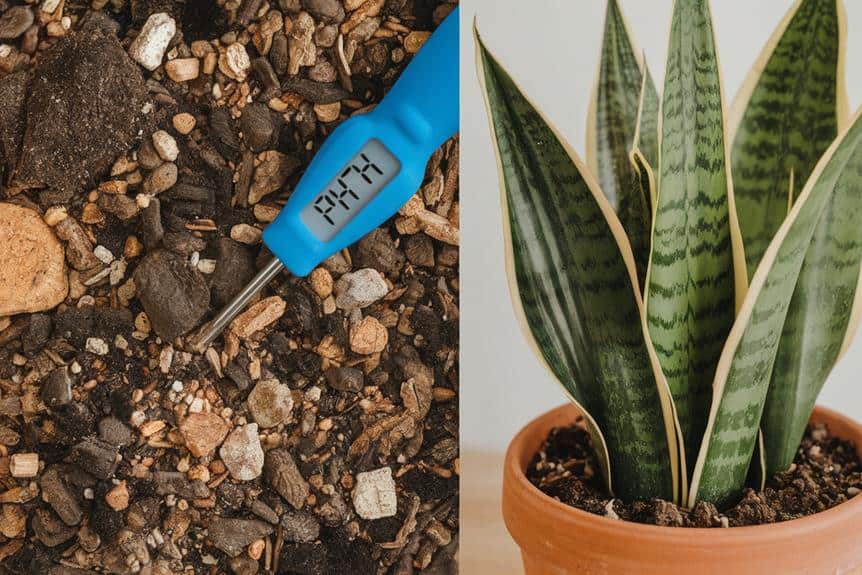
Most snake plants thrive in slightly acidic to neutral soil with a pH range of 5.5 to 7.5. To guarantee your snake plant’s health, you’ll want to maintain this ideal pH level. You can easily test your soil’s pH using a home testing kit or digital meter. If you need to adjust the pH, add lime to raise it or sulfur to lower it.
As for nutrients, snake plants aren’t heavy feeders, but they do benefit from a balanced fertilizer. Look for a mix with equal parts nitrogen, phosphorus, and potassium (NPK). Apply a diluted liquid fertilizer once every 2-3 months during the growing season. Remember, it’s better to under-fertilize than over-fertilize, as excess nutrients can harm your plant. By preserving the right pH and nutrient levels, you’ll help your snake plant flourish and better serve its purpose as an air-purifying, low-maintenance houseplant.
